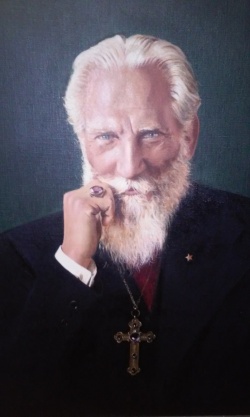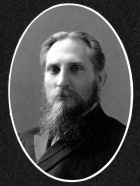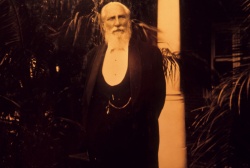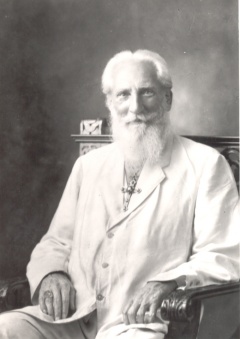Charles Webster Leadbeater: Difference between revisions
Donald Myers (talk | contribs) No edit summary |
Donald Myers (talk | contribs) |
||
| Line 71: | Line 71: | ||
As a result the LCC combines an elaborate, “high” Christian liturgy with freedom of thought. The church’s website states: | As a result the LCC combines an elaborate, “high” Christian liturgy with freedom of thought. The church’s website states: | ||
''The Liberal Catholic Church erects no barriers around its altars. All who come in a spirit of reverence are welcome to Holy Communion and to all other services of the Church. What opinions or beliefs an individual holds is considered to be his/her own affair. The mind that is free is in the best condition to grow. Growth into spirituality enhances the perception of truth which each one must discover for himself/herself and in his/her own way. Anything less than full mental freedom is thought to retard progress. Thus, the difference between The Liberal Catholic Church and all other Catholic and Protestant Churches lies in the fact that with the ancient sacramental worship have been associated the widest measure of intellectual freedom and respect for the individual conscience.''<ref>Richard Smoley, "The Liberal Catholic Church Celebrates Its Centenary," ''[http://www.innerchristianity.com/blog.htm?post=1021671 | ''The Liberal Catholic Church erects no barriers around its altars. All who come in a spirit of reverence are welcome to Holy Communion and to all other services of the Church. What opinions or beliefs an individual holds is considered to be his/her own affair. The mind that is free is in the best condition to grow. Growth into spirituality enhances the perception of truth which each one must discover for himself/herself and in his/her own way. Anything less than full mental freedom is thought to retard progress. Thus, the difference between The Liberal Catholic Church and all other Catholic and Protestant Churches lies in the fact that with the ancient sacramental worship have been associated the widest measure of intellectual freedom and respect for the individual conscience.''<ref>Richard Smoley, "The Liberal Catholic Church Celebrates Its Centenary," ''[http://www.innerchristianity.com/blog.htm?post=1021671 Richard Smoley's Blog (February 17, 2016)].</ref> | ||
== Years at The Manor == | == Years at The Manor == | ||
Revision as of 21:11, 19 February 2016
ARTICLE UNDER CONSTRUCTION
ARTICLE UNDER CONSTRUCTION
Charles Webster Leadbeater was an English Theosophist associated with the Theosophical Society based in Adyar, Chennai, India. He was best known for his extensive writings, his clairvoyant observations, and his involvement in the early life of Jiddu Krishnamurti.
Early life
Charles Webster Leadbeater was born in Stockport, Cheshire, England to Charles and Emma Leadbeater. According to the English census of 1861, 1871, and 1881 his date of birth was February 16, 1854. However, after his mother died in May 1882, his date of birth was given as February 17, 1847, and it appears so in the 1891 census and in his passport. This is the date he used during his Theosophical life.
According to C. Jinarajadasa, the Leadbeater family was Norman French in origin, with name Le Batre (the builder), later Englished to Leadbeater. One branch of the family followed "Prince Charlie of the Stuart dynasty and its custom was to christen the eldest son "Charles".[1]
In 1858 the family went to Brazil, and his father died a few years later, in 1862.
In December 21, 1879, following the footsteps of his uncle, Mr. Leadbeater was ordained a priest in the Church of England. However, he always kept an open mind for things that did not fall within orthodox Christianity, such as psychic and Spiritualistic phenomena. Whenever he heard of ghosts or hunted houses he conducted his own investigations. He also attended the lectures given by Annie Besant (then an atheist) at the Hall of Science.
Coming in touch with the Master
In 1883, Mr Leadbeater read a copy of A. P. Sinnett’s book The Occult World and became very interested in Theosophy. He met the author, who was at the time receiving letters from two of the Masters of Wisdom, and joined the London Lodge of the Theosophical Society, in November 1883. He was immediately attracted to the ideal of the Masters and felt that each "should set before himself the definite intention of becoming a pupil of one of the great Adept Masters".
One day, while investigating Spiritualistic phenomena with renowned medium and Theosophist William Eglinton, one of the latter's Spirit-guides named "Ernest" assured he could transmit a letter from Mr. Leadbeater to the Masters. On March 3, 1884, he wrote a letter to Master K.H. offering himself as a chela so that he could "learn more of the truth". He sent the letter to Mr. Eglinton, who placed it in a box he had for Ernest's use, and from which it eventually disappeared. Several months passed and he did not receive any reply.
In the meantime, he met Mme Blavatsky, who arrived at London on April and unexpectedly attended a rather troubled meeting of the London Lodge where new officer were being elected. He described the "truly tremendous impression" that Mme. Blavatsky had on him. Her plan was to stay in Europe until November 1st of that year, when she was to sail for India. On October 30, two days before her departure, Mr. Leadbeater traveled to London to say good-bye to HPB. He stayed the night with the Sinnett's. That evening HPB informed him that "D.K." had said that the Master had sent a reply to his letter of March 3rd. On the next day, Mr. Leadbeater returned to his house and found the Master's letter, which opened as follows:
Last spring--March the 3rd--you wrote a letter to me and entrusted it to "Ernest". Tho' the paper itself never reached me--nor was it ever likely to, considering the nature of the messenger--its contents have.[2]
In the letter the Master said that a member should "force" the Master to accept him as a chela by doing good works for humanity, working on self-purification, and making sacrifices for the Theosophical cause. He also warned CWL that he would have to atone for the collective karma of the Christian clergy to which he belonged. Finally, the Master suggested that he could go to Adyar to work for a few months. The letter closes with the following words:
So now choose and grasp your own destiny, and may our Lord's the Tathagata's memory aid you to decide for the best. K. H.[3]
He decided to follow the Master's suggestion. However, he found out he could not take a leave of absence from his position in the local Church school, of which he was manager--he had to resign to it. He decided to go back to London to talk to Mme. Blavatsky (who was leaving London the next morning) and, through her agency, ask the Master whether he wanted him to take this more drastic action. Late that night, in a gathering of some Theosophists that had come to say farewell to HPB, the answer was precipitated on her open hand, witnessed by several people. It said:
Since your intuition led you in the right direction and made you understand that it was my desire you should go to Adyar immediately – I may say more. The sooner you go the better. Do not lose one day more than you can help. Sail on the 5th if possible. Join Upasika at Alexandria. Let no one know you are going and may the blessing of our Lord, and my poor blessing shield you from every evil in your new life.
Greeting to you my new chela. K.H. Show my notes to no one.[4]
Early Theosophical work
In 1886 Leadbeater was a member of the small headquarters staff at Adyar, along with President-Founder Colonel Olcott, A. J. Cooper-Oakley, and a few Indian workers. Very little money was coming into Adyar in those days apart from small incomes made selling books and coconuts. "When the [carriage] horses died one after another, for several months Mr. Leadbeater, as acting editor of The Theosophist had to walk the seven miles to Madras with proofs, etc."[5]
When Olcott founded Ananda College in Colombo, Ceylon (now Sri Lanka) on November 1, 1886, he installed Leadbeater as the first principal. While in Ceylon, Leadbeater served as General Secretary of the Theosophical Society in that country from 1888-1889.[6]
International lecture tours
Krishnamurti
In May, 1909, C. W. Leadbeater ran into 13-year old J. Krishnamurti who was playing in the beach, and sees "the most wonderful aura he has ever seen, without a particle of selfishness". Although Theosophist and scholar Ernest Wood, who had tried to help him with his homework, considered him dim-witted, Leadbeater predicted that he would become a spiritual teacher and a great orator "much greater" than even Annie Besant.[7]
CWL nourished, educated and trained young Krishnamurti, who gradually began to resent the discipline imposed on him. As he became a teenager and left Adyar to live in Europe, he grew rebellious about his supposed spiritual role, and their relationship got more distant. But in 1922 this changed.
J. Krishnamurti arrived to Sydney in April to attend the Australian National Convention. There, he saw again CWL after about ten years. He wrote in a letter to Lady Emily C.W.L. was "just the same", and added: "He is much whiter in hair, just as jovial & beaming with happiness. He was very glad to see us. He took my arm & held on to it & introduced me to all with a 'voilà' in his tone. I was very glad to see him too."[8]
During one of the meetings at the Convention an argument pro and con CWL broke out. J. Krishnamurti, who was present, spoke out and declared that he knew Leadbeater better than most of those present, and that he could speak with some authority. As he reported later, he then declared that CWL "was one of the purest and one of the greatest men I had ever met. His clairvoyance may be doubted but not his purity."[9]
After Kirshnamurti left Australia he began to meditate and regain his touch with the Masters, as a result of which he had a a life-altering experience. After this he wrote to CWL:
I began consciously and deliberately to destroy the wrong accumulations of the past years since I had the misfortune of leaving you. Here let me acknowledge with shame that my feelings towards you were not what they should have been. Now, they are wholly different, I think I love and respect you as mighty few people do. My love for you when we first met at Adyar has returned bringing with it the love from the past. Please don't think that I am writing mere platitudes and worn out phrases. They are not and you, my dearest brother, know me, in fact better than myself. I wish, with all my heart, that I could see you now.[10]
Liberal Catholic Church
By far the greatest influence on the Liberal Catholic Church (LCC) was C.W. Leadbeater (1854–1934), a former Anglican priest who became a pupil of H.P. Blavatsky in 1884 and who went to India in 1886. Here, it is said, he developed certain clairvoyant abilities under the direction of the Theosophical Master Koot Hoomi, including the ability to see otherwise invisible “thought forms.” He and Annie Besant, later president of the Theosophical Society, did a number of clairvoyant investigations and published their results in books such as Thought Forms.
Leadbeater’s clairvoyant abilities shaped the development of the LCC. In 1920 he published his magnum opus, The Science of the Sacraments, which described the astral forms that he saw when the Christian sacraments were performed.
The Eucharist, or mass, said Leadbeater, was particularly powerful. “It is a plan,” he wrote, “for helping on the evolution of the world by the frequent outpouring of floods of spiritual force.” When properly enacted, he said, the ceremony created an astral “thought-edifice” that can take on any number of variations, although it is usually based on a foursquare ground plan surmounted with a dome. Leadbeater even said that “the Church of Sancta Sophia at Constantinople was erected in imitation of one of these spiritual edifices.”
To create as powerful a vehicle as possible, the celebrant needs to perform the Eucharist correctly and with intention (as opposed to rote mechanical enactment). The Catholic and Anglican rites of Leadbeater’s day were, he said, defective, so he and Wedgwood recast them. “We set to work to eliminate the many features which from our point of view disfigure and weaken the older liturgies,” James Ingall Wedgwood later wrote. “References to fear of God, to His wrath and to everlasting damnation were taken out, also the constant insistence on the sinfulness and worthlessness of man.” The resulting liturgy was published in 1919.
As a result the LCC combines an elaborate, “high” Christian liturgy with freedom of thought. The church’s website states:
The Liberal Catholic Church erects no barriers around its altars. All who come in a spirit of reverence are welcome to Holy Communion and to all other services of the Church. What opinions or beliefs an individual holds is considered to be his/her own affair. The mind that is free is in the best condition to grow. Growth into spirituality enhances the perception of truth which each one must discover for himself/herself and in his/her own way. Anything less than full mental freedom is thought to retard progress. Thus, the difference between The Liberal Catholic Church and all other Catholic and Protestant Churches lies in the fact that with the ancient sacramental worship have been associated the widest measure of intellectual freedom and respect for the individual conscience.[11]
Years at The Manor
Return to Adyar
In 1929, Annie Besant wrote:
My Brother Leadbeater, after nearly 16 years' residence in Australia, has returned to Adyar to make his home here as of yore. For several years he has been living in Australia for nine months and making a three months' trip to Adyar. Now he retires to reverse that process. I am happy to have him with me again, for he is always a tower of strength and a fount of wisdom.[12]
Writings
Mr. Leadbeater wrote an extensive body of work, which is listed in Leadbeater writings. Often he collaborated with Annie Besant in writing about esoteric subjects. Young people such as Basil Hodgson-Smith and Fritz Kunz assisted with his massive correspondence, and Ernest Wood helped to compile some of the books.
Later years
He passed away on March 1, 1934 in Perth, Western Australia.
Honors and awards
Ananda College in Colombo, Sri Lanka awards the C. W. Leadbeater Challenge Trophy in honor of the first principal of the school.
The large 3-story residential building for visitors at Adyar is called Leadbeater Chambers. It was the first concrete building of its size in India, and the cornerstone was laid March 17, 1910 by Annie Besant.
Notes
- ↑ Curuppumullage Jinarājadāsa, The "K. H." Letters to C. W. Leadbeater (Adyar, Madras: The Theosophical Publishing House, 1980), 53.
- ↑ Curuppumullage Jinarājadāsa, The "K. H." Letters to C. W. Leadbeater (Adyar, Madras: The Theosophical Publishing House, 1980), 12.
- ↑ Curuppumullage Jinarājadāsa, The "K. H." Letters to C. W. Leadbeater (Adyar, Madras: The Theosophical Publishing House, 1980), 14.
- ↑ Curuppumullage Jinarājadāsa, The "K. H." Letters to C. W. Leadbeater (Adyar, Madras: The Theosophical Publishing House, 1980), 52.
- ↑ C. Jinarājadāsa, "Administration of Adyar Headquarters," The American Theosophist 36.5 (April, 1947), 73-75, 82.
- ↑ "General Secretaries". The Theosophical Year Book, 1938. (Adyar, Madras, India: Theosophical Publishing House, 1938), 152.
- ↑ Mary Lutyens, Krishnamurti: The Years of Awakening (New York: Farrar, Straus and Giroux, 1975), 21.
- ↑ Mary Lutyens, Krishnamurti: The Years of Awakening (New York: Farrar, Straus and Giroux, 1975), 140.
- ↑ Mary Lutyens, Krishnamurti: The Years of Awakening (New York: Farrar, Straus and Giroux, 1975), 143.
- ↑ Mary Lutyens, Krishnamurti: The Years of Awakening (New York: Farrar, Straus and Giroux, 1975), 160.
- ↑ Richard Smoley, "The Liberal Catholic Church Celebrates Its Centenary," Richard Smoley's Blog (February 17, 2016).
- ↑ General Report of the Theosophical Society, 1929, page 21-22.
Online resources
Articles and pamphlets
- An Appreciation of C. W. Leadbeater by Geoffrey Hodson
- C. W. Leadbeater - A Great Occultist Compiled by Sandra Hodson and Mathias J. van Thiel
- C.W. Leadbeater in Retrospect By Hugh Shearman
Additional resources
- CWL World
- Articles by and about C.W. Leadbeater at Katinkahesselink.net



